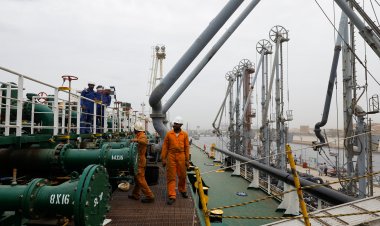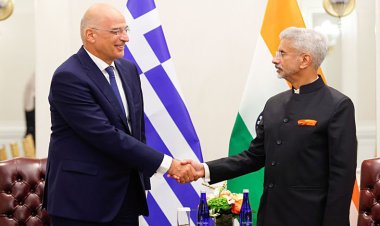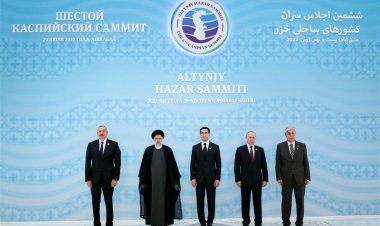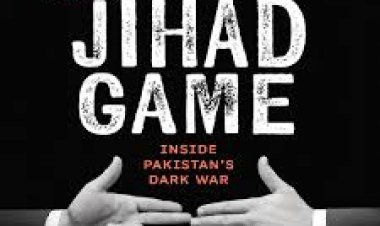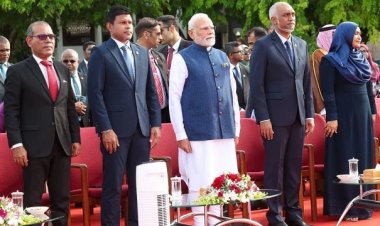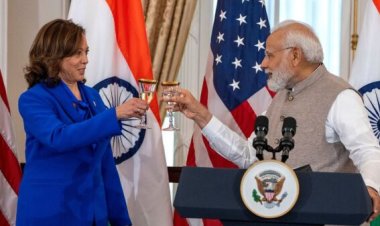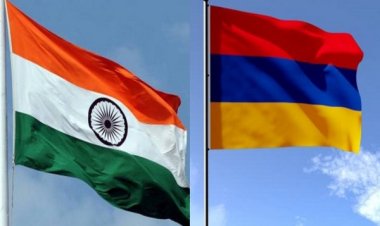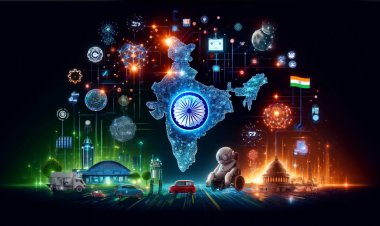One Belt, One Road: What Lies Ahead for India?
India should keep the doors of engagement with China open to carve out a niche for itself in the One Belt, One Road initiative.
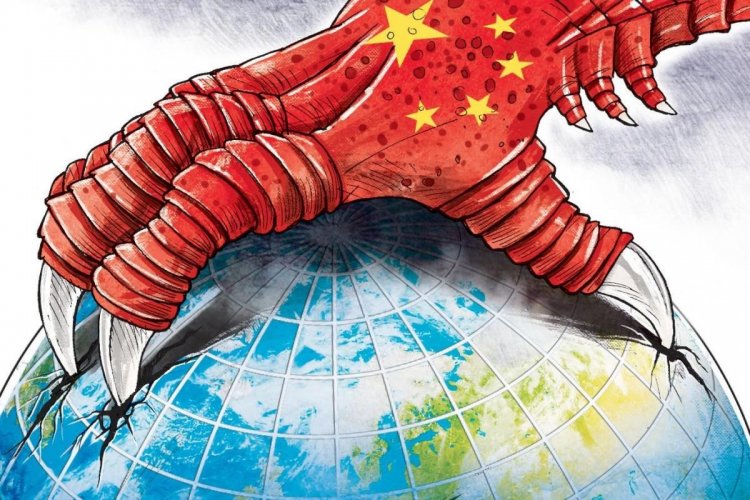
Analysis
By Abhinav Pandya
The old saying, “When the dragon sneezes, the world catches cold” has acquired completely new meaning after the low-key announcement of the One Belt, One Road (OBOR) initiative by China’s President Xi Jinping in 2013. The cloak of secrecy has always been the characteristic feature of the Middle Kingdom and this has already disturbed the world of diplomacy and intelligence. Coupled with its increasingly assertive posture in the South China Sea, the OBOR initiative has come to be looked upon as a “silk glove for Chinese iron fist.”
In general, it has raised perceptible uneasiness among the leading world powers, but, in the case of India, the fears are alarming, as the dragon is spitting fire right in India’s backyard. India didn’t send a single embassy official to the recent OBOR summit in Beijing. The Ministry of External Affairs (MEA) of India stipulated that anyone from think tanks, business chambers and other ministries would have to get clearance if they were attending the forum.
Further, the MEA released a comprehensive statement questioning the sanctity and objectives of the initiative on the grounds that the OBOR initiative violates India’s territorial integrity because China-Pakistan Economic Corridor (CPEC) falls in Pakistan-Administered Kashmir, which is Indian territory. Secondly, the projects appear to have hidden motives, with soft loans that could trap smaller countries in a crushing debt cycle. There can be adverse effects on ecology and the environment, leading to the disruption the local communities.
New Delhi is also wary of China’s intentions and views the project with suspicion, tacitly accusing China of enhancing its global geopolitical influence under the veneer of expanding road networks and encircling India. Chinese investment and interference with India’s immediate neighbors like Nepal, Sri Lanka, Bangladesh and Myanmar lends a sense of immediate fear among the intelligence community and foreign policy mandarins of India.
String of Pearls
Closer analysis reveals that it is not just OBOR that has raised the fear in Indian strategic circles. In fact, these concerns have been accumulating since the days of what many Indian strategists refer to as the “String of Pearls.” The String of Pearls is a theory, popular in Indian strategic and intelligence circles, which argues that China is trying to cordon off India by spreading a network of dual-use ports connecting its eastern coast to the Middle East that would boost its strategic clout and maritime access.
India’s strategic community sees OBOR as nothing but the transformation of this “string of pearls” into a more systematic and deceptive strategy loaded with covert revanchist ambitions hidden under the cloak of economic development and shared prosperity. Brahma Chellany, India’s leading China expert, writes in The Japan Times: “Indeed, by working to establish its dominance along the major trade arteries, while instigating territorial and maritime disputes with several neighbors, China is attempting to redraw Asia’s geopolitical map.” Former Indian Foreign Secretary Shyam Saran sees OBOR as not just an economic initiative but one that has clear political and security implications — “a carving out by China of a continental-marine geostrategic realm.”
The central debate here is not whether India’s concerns are genuine or not. Given the history of conflict between the two countries and China’s all-weather friendship with Pakistan, the gravity of India’s concerns cannot be trivialized. However, the matter of importance here is India’s response to the grand designs of the Middle Kingdom.
The most pressing of India’s concerns is the implementation of CPEC on territory claimed by India amounting to the violation of the territorial integrity and sovereignty of India. It is indeed a genuine concern, but by not joining the initiative, India is giving Pakistan and China a free hand in Pakistan-Administered Kashmir — the so-called “disputed territory.” In a situation where India does not have an effective political control over the territory, leaving it open for a multilateral infrastructure project with a clear focus on transport corridors amounts to virtually giving a free rein to China and Pakistan. In due course, their stakes and economic and strategic foothold in the area will be so strongly entrenched that it will be virtually impossible for India to hold any claim. India will have a mere legal locus standi in that case, and when it comes to disputes where a large geographical area is involved, India must have a strong cultural, economic and social connection to the region and its people. These unofficial links will strengthen India’s foothold and provide substance to the claim in the future if the matter comes to legal negotiations.
In The Times of Central Asia, James Dorsey informs that a leaked long-term plan for China’s massive $56-billion investment in Pakistan exposes the goals of Beijing’s One Belt, One Road initiative as a “ploy for economic domination, the creation of surveillance states, and allowing China to influence media landscapes.” The leaked plan also revealed that a full system of monitoring and surveillance would be built in Pakistani cities to ensure law and order. The system will be based on an array of explosive detectors and scanners to “cover major roads, case-prone areas, and crowded places … in urban areas to conduct real-time monitoring and 24-hour video recording.”
The plan also outlines how Pakistan would be turned even more than it already is into a surveillance state where freedom of expression and the media are manipulated. It also suggested the degree to which OBOR is designed to establish China as Eurasia’s dominant power based on economics, as well as the adoption of measures that undermine democracy or inhibit political transformation in autocracies.
The leaked plan may not be a complete picture of China’s modus operandi, but it certainly unravels the subtle nuances of China’s hidden motives. And, if Chinese designs include surveillance, then India must foresee the possibility of highly sophisticated intelligence installations and activity in the neighborhood and Pakistan-Administered Kashmir. Such activities are hidden in nature and in the long term could be highly detrimental to India’s national interests. Therefore, it becomes all the more important to be part of this initiative, not for the reasons of morality or goodwill, but purely for the logic of statecraft and the protection of India’s national interests.
Transforming the Status Quo
Secondly, discounting all the nefarious designs and hidden motives, it cannot be denied that the OBOR initiative offers tremendous economic opportunities. The highways and rail links built in the highly volatile and sensitive region of Eurasia and the maritime routes will be the lifeline of international trade and commerce in the future. Staying away from such a grand project is like a self-imposed economic exile. In a globalized and interdependent world of today, this will be a blunder of Himalayan heights and will result in putting major hurdles in India’s economic growth and finally in isolation, both diplomatic as well as economic.
China has already hinted at this, though in the form of a mild threat. It must be recognized that at the core the OBOR initiative is a multilateral economic regime that has all the potential to herald a new breakthrough in the global trade and commerce and completely transform the postwar economic order. At this stage, China has made attempts to cajole India to join. The project is in a nascent state but, with time, China might grow stronger and capture the vantage points of this international economic regime. At that point, India will have no clout to control, regulate and manipulate the economic and geopolitical trends that emanate from the initiative. Hence, it becomes necessary to see beyond the petty issues of ego and minor interests of domestic electoral politics and join the initiative. The best way forward is to hop on the bandwagon and carve out a niche, chipping away at China’s clout. This is what the world powers are aiming at. US and Japan, though officially not part of the initiative, have sent their representatives. American companies have been awarded big contracts in CPEC.
Further, India has nothing to fear. While One Belt, One Road captured the world’s imagination in 2013, it is essential to note that India is at the center of many regional connectivity projects like the Chahbahar port (with Iran) and Zaranj-Dalaram highway. Another project with which India is associated is the International North-South Transit Corridor (INSTC). The INSTC was started in 2000, almost a decade before OBOR, and initially brought together India, Iran and Russia to create multi-modal links (ship-rail-road) from India to Europe via the Gulf, Central Asia and Russia. The partnership later included Turkey and other Central Asian republics. The Ashbaghat Agreement, that brings together India, Oman, Iran and the Central Asian republics, was initiated in April 2011.
In South Asia, Indian projects include the development of the Andaman and Nicobar Islands in the Bay of Bengal into a maritime hub, including a dry dock and a shipbuilding facility. At the Sri Lankan port of Trincomalee, India has been setting up a petroleum hub. Another One Belt, One Road project that already involves India directly is Bangladesh-China-India-Myanmar Economic Corridor (BCIM-EC), which is a combination of infrastructure and trade facilitation agreements.
Saadat Hasan Bilal writes in The Diplomat: “These (Indian Connectivity projects) might lack the dramatic impact of OBOR, but taken together, they bring together a number of solid partners and have the capacity to transform the regional economic and geopolitical landscape to India’s advantage. India, thus, has little need to feel insecure about OBOR.”
China has already recognized the need for more extensive and intensive dialogue with major actors like India, whose participation in One Belt, One Road would be crucial for the successful implementation of the project. If connectivity projects were to be negotiated among the various stakeholders with a cooperative spirit, the strategic value of the projects would increasingly pave the way for their more important economic value, which would be the true win-win that Chinese policymakers have been emphasizing lately. This will open the space for an active Indian role in projects that serve its interests, such as BCIM-EC and those that would promote links from South Asia to Central Asia and Russia.
Kautilya, the famous India theorist on statecraft, suggests it is important to monitor and contain the activities of the state’s “enemy” and its diplomacy through engagement and cooperation rather than war, which is becoming increasingly difficult in today’s globalized world. Hence, in line with Kautilya, it is beneficial for India to join OBOR, as Kautilyan principles strongly inform the philosophical moorings of India’s foreign policy.
Diplomatic Offensive
In Indian strategic circles, this writer did not come across any holistic analysis giving a bird’s-eye view of Indian fears or ways to address them. Informed analysis is lacking, and eminent diplomats and intelligence experts have been found providing analysis of Chinese ulterior motives that sound more like conspiracy theories rather than evidenced-based and logically consistent arguments. They mention the roadblock and the odds that China will face and, with a politically correct ease emanating out of the diplomatic comfort zone, they go on to predict a failure of the Chinese project.
One finds a measured analysis of India’s genuine concerns and the measures to check China’s so-called “diplomatic offensive,” to use Jaydeva Ranade’s, India prominent intelligence expert on China, phrase. Some, like Jay Shrinivasan, suggest a slew of measures to checkmate China, but they primarily focus on soft-power diplomacy harnessing the shared cultural and religious traditions of India with Central Asian countries. This sounds like a great idea loaded with wishful thinking, but it must be noted that One Belt, One Road’s core strength comes from China’s hard economic power.
The project has the potential to transform the trade and commerce in Eurasia, despite the hurdles outlined in my previous article. Giorgio Fiacconi writes in STRATFOR: “The undisputed potential of the project should give a positive impact to local economies from the very beginning, creating employment and parallel infrastructure and production facilities able to support the development while guaranteeing new development. Only in this way the project be seen as a source of mutually beneficial development and not a plan of Chinese control and dominance.”
Korean scholar Jae Ho-chung informs that when completed, OBOR will include “60 countries, with two-thirds of the world’s population, 55 percent of global GDP, and 75 percent of global energy reserves. It will consist of 900 infrastructure projects, valued at about $1.3 trillion.” India can forge economic partnerships with other countries like Japan and America, alarmed by Chinese initiative along the lines of what Zaid Haidar suggests for the US. In fact, India is already pursuing a maritime initiative with Japan that completely bypasses all Central Asian countries through a route as an alternative to One Belt, One Road. The project hardly brings any benefit to Central Asian countries. It looks more like a duplication of the costly and tedious facilities that are being used currently with a different nomenclature. Giorgio Fiacconi writes, “ The Indian proposal, moved by India’s dissatisfaction with the large Chinese investment through Kashmir territory controlled by Pakistan, will probably never see adequate implementation, but it clearly represents an obstacle OBOR should expect in developing its projects in this part of the world.”
Hence, along with forging partnerships with competing countries, it appears reasonable for India to keep the doors of engagement with China open and carve out a niche for itself in the OBOR initiative. On the bedrock of this niche, the future of One Belt, One Road will witness an active Indian role in the project on account of its historical and cultural ties with the participant countries. India can no longer afford to look at the OBOR initiative through the prism of 1962 and needs to explore all the opportunities of constructive engagement with China and the rest of the participating countries. This becomes even more important as India’s neighbors like Nepal, Sri Lanka and Bangladesh have already joined the initiative.
Yet, rapid economic changes with the presence of Chinese investors may cause social unrest. Chinese economic practices have always been under suspicion as regards labor welfare, environmental concerns and benefits to local communities. Overall, Chinese firms prefer to hire Chinese nationals, which has already led to resentment in many countries across Asia and Africa where Chinese projects are being implemented. Further, due to intense religious tensions in the region, the projects may be endangered by the terrorist attacks.
Many Asian nations are tired of being pawns in the strategic games between Russia and the US. China offers an understanding of their socio-political dynamics, political support and immediate financial help and fast development.
The Belt and Road investments will also serve to build political support for China. Many countries along the proposed transportation corridors face huge budget shortfalls in the area of infrastructure development, together totaling trillions of dollars between 2010 and 2020. Chinese investment will be crucial for these countries that need financial resources but are banned by Western financial institutions on accounts of corruption, insufficient structural reforms, lack of democracy and poor human rights records. China, with its enormous resources, is supposed to fill some of these gaps. The New Silk Road initiative means strong Chinese diplomatic activity in Eurasia, backed by intense economic cooperation that in turn will lead to better bilateral relations with the partner countries.
The US and Europe are skeptical of engaging countries with a poor record of democracy. China’s cooperation with Iran, Syria and Russia may not be approved in the West, but it is immensely useful; China gets international legitimacy and a heightened importance on the global arena. This might also hamper the democratizing efforts of the West.
The military aspects of cooperation are of great importance to Beijing. The ports constructed as a part of Belt and Road programs could be used for dual purposes, such as commerce and naval, in the times of maritime conflict. Gwadar is of great strategic value as it is located in the Strait of Hormuz. Colombo harbor in Sri Lanka enables China to get a stronghold in the Indian Ocean. Besides, new Chinese outposts like Djibouti in Ethiopia and the People’s Liberation Army (PLA) activities in the South China Sea and the Indian Ocean show increasing assertiveness of China in the naval matters, feared by its biggest counterweights such as India, Japan and the US.
Hidden Agendas
The road ahead is not easy. Beijing’s initiative sparks controversy and suspicions. China is already facing the allegations of lack of transparency, poor human rights record, obscure business practices, government overreach and the neo-colonial character of the trade relationship with developing countries: Chinese companies that employ Chinese workers reduce the benefits to the local population in the host country. China has been accused of supporting authoritarian regimes, paying low wages, non-compliance with worker safety norms, environmental safety concerns.
Further, there are issues pertaining to corporate governance and unfair practices related to Chinese technology and preference for its own companies. Aid is usually seen as loaded with expectation. Some African countries might face financial crises due to increasing expenditure connected with Chinese investment.
Rafiq Dosani of the Rand Corporation writes that China is targeting countries with wobbly governments, terrorist activity, illiteracy and inhospitable terrain. So, if China’s scheme to erect highways, railways, power grids, pipelines and other projects fails — and there will be some failures — host governments could be left deeply in debt, ruining China’s relations with them on a long-term basis. Fears have arisen from several quarters that partner countries may fall into some kind of a debt trap.
If the project succeeds, China will be the greatest regional power and in the East, with its influence exceeding that of the traditional partners like the US and Europe. China’s political influence will be entrenched in its possessed economic power, but for that China will have to ensure peaceful development and the profitability of the project to all partner countries. It will have to eliminate all the unfair practices and improve its image abroad. Upon such terms China could emerge as a successful leader and the success of the project will bring jobs and economic prosperity and peace in partner countries which will make them further dependent on China.
Further, new financial instruments created by Beijing, like the Asian Infrastructure Investment Bank, the Silk Road Fund and the New Development Bank will help to reduce the dependence on the Western-led lending institutions like the World Bank and the International Monetary Fund. China’s strong role in the above-mentioned alternative sources of lending already threatens the status quo of the postwar global economic order.
The Long March Forward
Chinese’ march ahead has already stimulated the changes in the status quo as some countries are hopeful of the economic benefits through partnership, whereas others are forging new alliances to balance China. For example, Turkey is warming up to China for economic benefits and hence balancing its dependence on NATO. Nepal and Sri Lanka have joined Belt and Road initiative, alarming India. Kazakhstan is pursuing cozy relations with Moscow. India is forging ties with Japan.
Many Asian nations are tired of being pawns in the strategic games between Russia and the US. China offers an understanding of their socio-political dynamics, political support and immediate financial help and fast development. However, Chinese initiatives still generate mixed feelings due to its complicated history, clandestine nature of operations and the recent assertiveness in foreign policy. Therefore, in order to ensure the success of the project, its foreign policy will have to be smart and cautious.
European nations have joined the OBOR initiative while Washington remains suspicious. It has already resulted in frictions between Brussels and Washington. It is highly unlikely that Europe will turn its back on the profitable economic partnership with China, and China also values the secure investments in Europe and access to technology. Further, Sino-European rapprochement could go a long way in undermining the transatlantic alliance and will strengthen China’s global status and its appetite for power. Further, with Trump’s isolationist policy, China might have a strong opportunity to reclaim its historic presence in global economic and strategic affairs. Partnerships forged through OBOR could be successfully used in future to resolve disputes and crises situations lending China a hefty role as mediator.
The Belt and Road initiative has a strong potential to serve as a great source of regional integration, political stability and economic empowerment, transforming Asia into a truly global player. Just by size alone, China is already influencing and transforming the global order in myriad ways, and even the effects of China’s internal economic problems can be felt in developing nations dependent on China’s investments. In this new era, the old phrase “When China sneezes, the world catches a cold” takes on a completely new meaning with immense utility for intelligence czars, diplomatic circles and corporate forces.
As regards the One Belt, One Road initiative, it is undoubtedly a multilateral economic regime with strong undercurrents of China’s global political ambitions that has immense potential to herald a new world order. However, at this stage, rather than dwelling on conspiracy theories and unknown fears, it is better to join the initiative. For Europe, US, India and other powers the only way to deal with Chinese expansion is, first of all, to accept and understand it, and then carve out a niche for themselves in the new regime. Once they create their stakes and influence, the effective functioning of the world order won’t merely be Chinese power play.
Abhinav is the author of “Radiclaization in India: An Exploration.” He is a Strategic Affairs Analyst with an extensive counter-terrorism experience in Kashmir. He is also the founder and CEO of Usanas Foundation.
Disclaimer: The paper is the author’s individual scholastic articulation and the facts and figures quoted are duly referenced, as needed, and are believed to be correct.
The article was originally published by Fair Observer.

